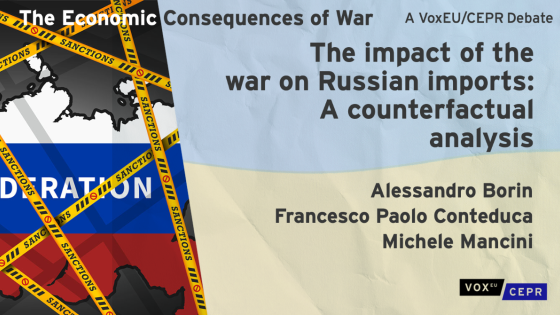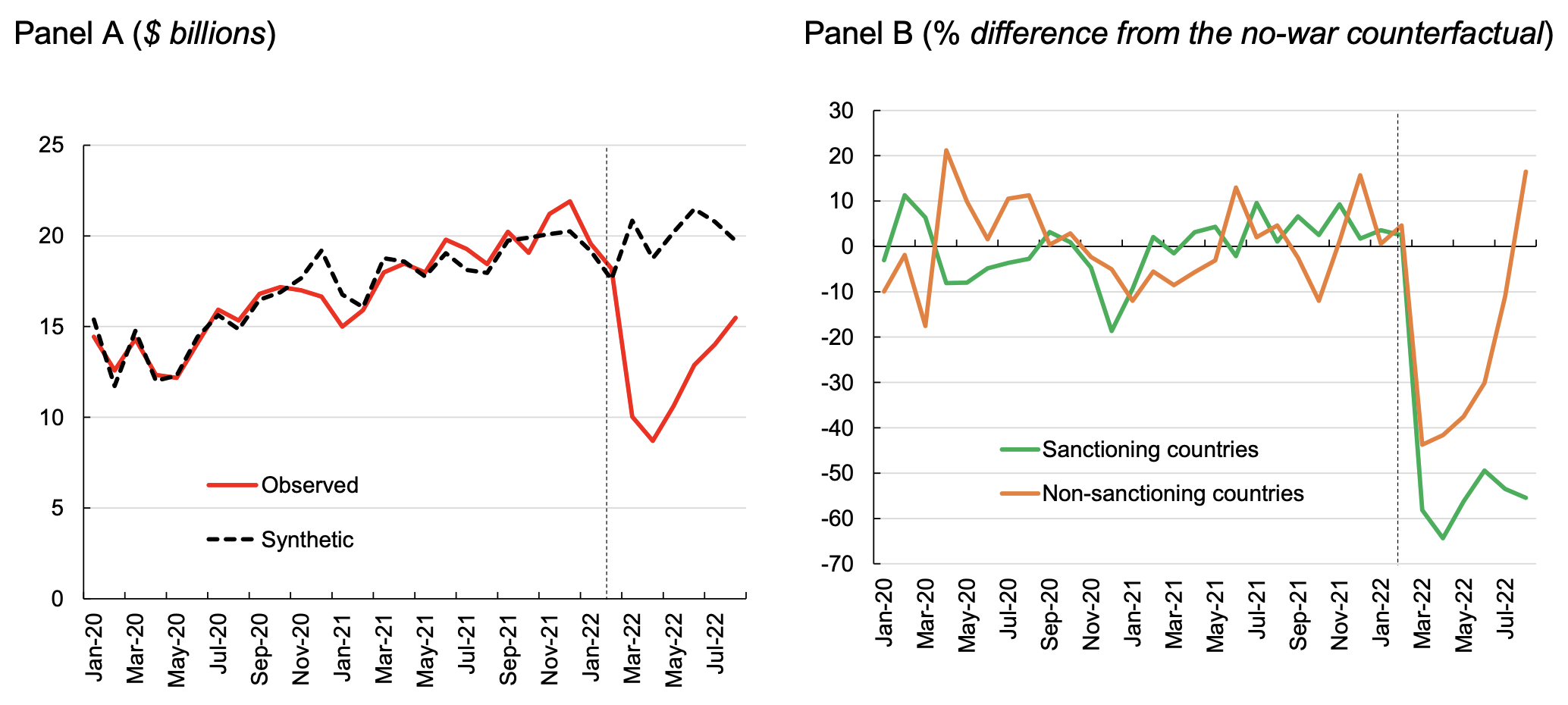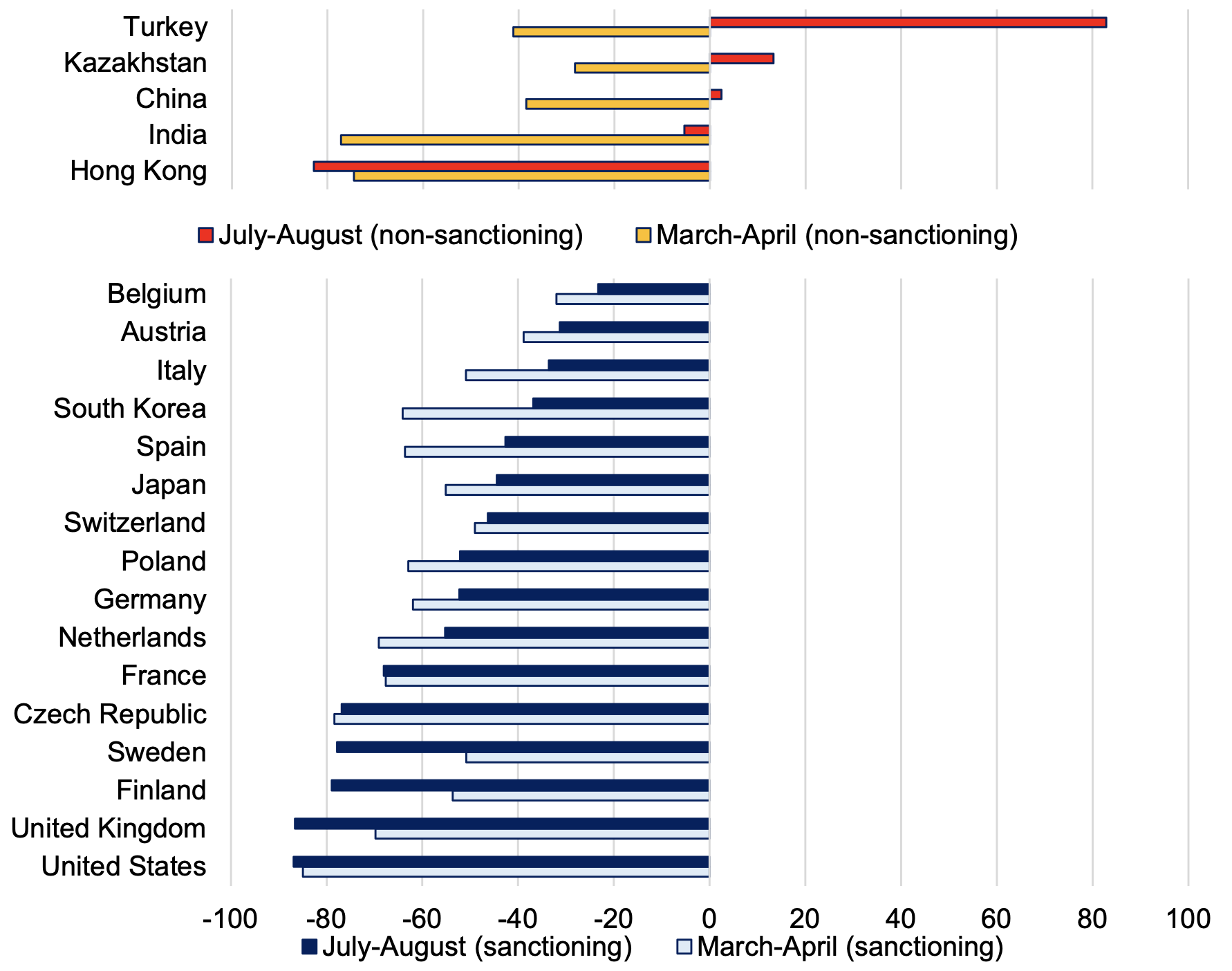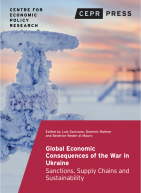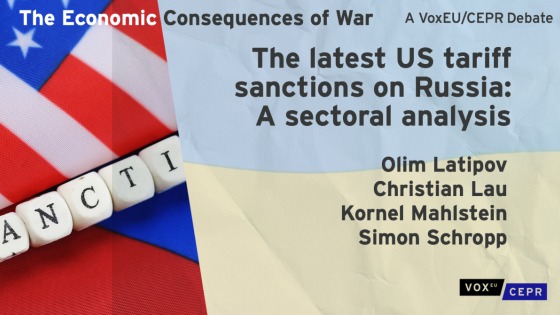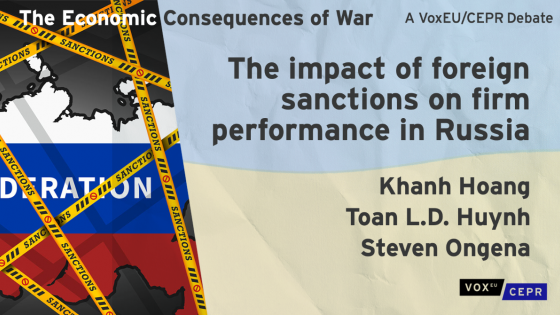Editors' note: This column is part of the Vox debate on the economic consequences of war.
Following the Russian invasion of Ukraine on 24 February, the EU and most other advanced economies imposed extensive sanctions on Russia. On the trade side, sanctions restricted the list of goods and services that can be exported to and imported from Russia. Additional sanctions were imposed on the financial sector, e.g. excluding most Russian banks from SWIFT, as well as targeting assets of specific individuals and banning them from traveling into sanctioning countries (see Garicano et al. 2022). Moreover, several multinational enterprises, including large transport and logistics firms, exited the Russian market.
Six months after the invasion, an assessment of the overall impact of these factors on the Russian economy remains complex, partly because Russia ceased to publish many key statistics.
In recent months, both private forecasters and public institutions have revised on the upside their projections of Russian GDP growth for 2022. Nonetheless, the outlook for the Russian economy remains grim on many metrics. In fact, these revisions are mainly driven by skyrocketing energy prices and dropping imports. The large current account surplus has undoubtedly contributed to sustaining the ruble. However, it also stems from the mechanical fall in imports due to the war and related sanctions, and it does not represent a good indicator of the strength of the Russian economy and its production capabilities.
Instead, the evolution of Russia’s imports provides a helpful metric to glean the implications of the conflict and sanctions on its economy as it relates tightly to Russia’s short- and long-run growth. First, the availability of foreign products clearly affects the welfare of Russian consumers by reducing varieties of goods and increasing consumer prices. Second, domestic production relies on imported intermediate and capital goods in many sectors. Some sectors are already recording dramatic contractions in activity due to the lack of foreign components (e.g. car production fell around 77% year-on-year in September).
In a recent contribution (Borin et al. 2022), we develop a framework to assess the effect of the war and following sanctions on Russia’s imports almost in real time. First, information on monthly export flows to Russia released by partner countries is exploited to overcome the lack of updated monthly official Russian import data (Simola 2022). Second, a synthetic control method (Abadie and Gardeazabal 2003, Saia 2017) is used to construct counterfactual scenarios for export flows to Russia had the conflict not occurred. For each exporter, the counterfactual exports to Russia are constructed by selecting an appropriate combination of export flows to partners other than Russia. For instance, in the case of Germany, the procedure determines the following combination of bilateral flows to replicate the German exports to Russia: 33% of exports to Algeria, 25% to Serbia, 22% to China, and 20% to Brazil. A specific counterfactual for each exporting country is derived similarly. The difference between the counterfactual and the actual data after February 2022 should capture the effect of the war on Russian imports.
Russian imports, as compared to the no-war counterfactual
The counterfactual analysis suggests that the conflict has almost halved total Russian imports between March and August 2022. Panel A of Figure 1 compares the evolution of observed exports to Russia with the synthetic counterpart. The synthetic control matches observed exports to Russia before the conflict (January 2020-January 2022). Following the war, we observe sharp decoupling between the two series. Actual exports plummeted in March and April while the synthetic control increased almost steadily. In April, the gap was at its widest, with actual flows 54% below their counterfactual. Initially, exports from both sanctioning and non-sanctioning countries contracted sharply, suggesting that the effect was not driven exclusively by the imposition of trade sanctions (Figure 1, Panel B). Since May, actual Russian imports rebounded, with non-sanctioning countries showing a much steeper recovery than non-sanctioning ones. In August, flows from sanctioning countries were 55% below the estimated no-war scenario. Instead, exports from non-sanctioning economies exceeded their counterfactual by 16%. Total exports to Russia stood 22% below their counterfactual, while 15% below their pre-war February level. This evidence suggests that a naïve counterfactual, such as that implied by a no-change scenario, would underestimate the drop in Russian imports by almost a third.
Figure 1 Effects of war on exports to Russia
Source: own elaboration based on Trade Data Monitor data.
Note: Panel A compares the evolution of the observed exports to Russia (solid) with a synthetic control calculated as described (dashed). Panel B reports the gap between observed exports and the synthetic control. The dotted vertical line corresponds to the start of the war (February 2022). The sample includes 50 countries’ exports to Russia, covering around 85% of Russian imports gauged through mirror statistics in 2021.
The impact has been very heterogeneous, even within sanctioning and non-sanctioning groups. In the former group, the US recorded the sharpest fall in export to Russia, 87% below their counterfactual. Most sanctioning countries recently narrowed the gaps with their no-war counterfactuals (Figure 2). Among non-sanctioning countries, Turkey is a stark outlier: after contracting in March and April, its exports to Russia rebounded sharply, exceeding the no-war counterfactual by more than 80% in July-August.
Figure 2 Effects of war on exports to Russia by origin country, March-April versus July-August
(% difference from the no-war counterfactual)
Source: own elaboration based on Trade Data Monitor data.
Note: the values on the x-axis are in percentage points. Countries within the list of top 25 exporters to Russia in 2021 are reported if trade data are available.
The war has disproportionately affected exports to Russia in the motor vehicle and electronics sectors, possibly due to sanctions targeted at specific products, like those with potential dual use.
According to our sectoral estimates, exports in the motor vehicle and electronics industries have been around 60% lower than in the no-war counterfactual. For these industries, the gap with the counterfactual remained above 40% (Figure 3). Together with machinery, which also suffered a significant decline, these industries account for about half of total global exports to Russia. The sharp drop in these imports may hurt the Russian economy in the short term and simultaneously hinder its potential long-term growth. Russia is highly dependent on imports of such goods (about 63% of Russia’s demand in these industries is satisfied by foreign production, compared to an average of 35% for the rest of the manufacturing sectors), and substitution with domestic products seems particularly hard given their relatively high technological content.
Figure 3 Effects of war on manufacturing exports to Russia
(% difference from the no-war counterfactual, March-April versus July-August 2022)
Source: own elaboration based on Trade Data Monitor data.
Note: red (blue) bars represent the gap in export to Russia between observed data and the synthetic control by sector in March-April (July-August) 2022. The values on the x-axis are in percentage points. We do not report results for ‘Non-metallic mineral products’ and ‘Other transport equipment’ since we are able to match a share of exports below 50% with the synthetic control.
Concluding remarks
We apply the synthetic control method to estimate trade flows to Russia in a no-war counterfactual using bilateral, sectoral trade statistics at monthly frequency. We find that the war and following sanctions have significantly impaired the ability of Russia to import goods from sanctioning and non-sanctioning countries by drastically hitting some critical, high-technology sectors. Even if exports from non-sanctioning economies exceeded their no-war counterfactual in recent months, suggesting that some trade diversion is taking place, the overall capability to source specific products has been crippled by the imposed restrictions. The substantial shortage of key inputs and consumer goods is likely to reduce Russian welfare and growth both in the short and long run.
References
Abadie, A and J Gardeazabal (2003), “The economic costs of conflict: A case study of the Basque Country”, American Economic Review 93(1): 113-132.
Borin, A, F P Conteduca, E Di Stefano, V Gunnella, M Mancini and L Panon (2022), “Quantitative assessment of the economic impact of the trade disruptions following the Russian invasion of Ukraine”, Bank of Italy, Economic Research and International Relations Area.
Borin, A, F P Conteduca and M Mancini (2022), “The impact of the war on Russian imports: a synthetic control method approach", ZBW Working Paper.
Felbermayr, G, H Mahlkow and A-N Sandkamp (2022), “Cutting Through the Value Chain: The Long-Run Effects of Decoupling the East from the West”, CESifo Working Paper.
Garicano, L, D Rohner and B Weder di Mauro (2022), Global Economic Consequences of the War in Ukraine: Sanctions, Supply Chains and Sustainability, CEPR Press.
Du, X and Z Wang (2022), “Multinationals, global value chains, and the welfare impacts of economic sanctions”, Economics Letters 220: 110870.
Saia, A (2017), “Choosing the open sea: The cost to the UK of staying out of the euro”, Journal of International Economics 108: 82-98.
Simola, H (2022), “Russian foreign trade after four months of war in Ukraine”, Bank of Finland Institute for Emerging Economies, Policy Brief.
